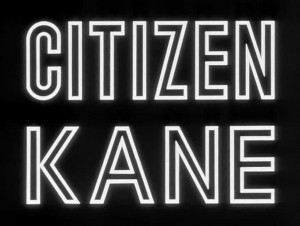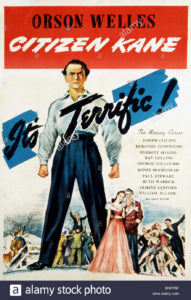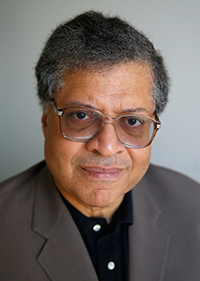I’m guessing this happened when I was 15 — or 16 at the latest. It had to be one of those years when I was still too young to be allowed (or invited) anyplace on New Year’s Eve, but was nonetheless given permission to stay up as late as I wanted while looking after my younger sibs, both of whom were dead asleep at that wee hour. I don’t suppose Channel 8 in New Haven keeps records for whatever movie they were broadcasting that far back, whatever year it was. But I do know it was New Year’s Eve. I know it was late. And I know it was Citizen Kane.
The reception wasn’t so hot; a little snow on the screen, possibly a lot more outside, the weather being whatever it was in central Connecticut that time of year. I’m bluffing. I don’t remember what it was doing outside because I didn’t care. If someone had broken into the house that night to take everything but the TV, I wouldn’t have noticed. Orson Welles’s greatest magic act had transfixed another unwary spectator. By the time the movie was over, my face was so close to the screen that it was ready and, likely, willing to push through the tube.
As has been the case with just about everyone else’s first encounter with Citizen Kane, I had never before suspected that a movie, any movie, was capable of doing the things with light, shadow and sound that Welles had done. All I asked from movies before that night was a story long enough to keep me occupied for a couple hours. Every once in a while, I’d get more than that. Alfred Hitchcock, that other supreme magician of light and shadow, had mesmerized me plenty of times by my teens. But the tension and menace were always out front in his movies with the big man’s gentle, but firm touch applying gradual pressure upon the viscera to see how much you could stand.
Welles’s movie didn’t press; it seeped, slithered like a dream with sounds that seemed both haphazard and orchestrated. It was as if the movie were another, larger room with the door opened a crack and I couldn’t keep myself from eavesdropping on the chattering ghosts inside. And there were these stark images coming at me at angles and perspectives I’d never seen before.
All of which sorcery was concocted to make me care about a man I wouldn’t have spent more than five minutes with in real life unless forced against my will. What movie could make anyone do that? What kind of movie could make you want to go through such dark mischief again? And again and again and again…?
I plan to put myself through it tonight — or early tomorrow at the latest. It’s an annual ritual that began more than ten years ago when, having become by that time a full-time movie reviewer for Newsday, I would get the inevitable “what’s-your-all-time-favorite-movie” question from civilians and found myself explaining (or trying to) my ongoing fascination with Citizen Kane. More often than not, the answer seemed to disappoint, even among those old enough to remember when Orson Welles was alive. (“’Citizen What?’” “Who’s in that?” “And that’s the story? Hmmm…”) All of which responses were variations on “Why didn’t you pick something I like?” Or, in most cases, have at least heard of.
Just the other day, a cousin living here in DC said, when I told her of my New Year’s plans, “I don’t know that one.” Then, after a pause, asked, “Is it a sad story?” If you’ve seen Citizen Kane at least once, you should have enough sense to immediately say, “Yes.” If you’ve seen it more than once and become enraptured enough with it to read (or watch) accounts of the comparably legendary back story of Citizen Kane’s making, you could even go to the trouble of saying that, it, too, is a sad story; some might say, even sadder than the movie itself.
And yet, even if one knows about Welles’s life story; the meteoric rise that led him to Hollywood, the crash-and-burn that followed Kane, the desultory decades of hit-and-miss movies, work-for-hire, commercials and talk-show appearances that marked his career ever afterwards, it becomes harder think of Kane the same way one thinks of other pictures. Is Charles Foster Kane’s life story a downer? Well, yes. Is the movie a downer? Absolutely not. Huh? What? Why?
OK, here goes: Because watching the movie is like hearing great bebop or rock-and-roll for the first time. Because of the brash exhilaration emitted by the movie itself, its willingness to go-for-broke at practically every bend and turn, to blend sounds and dialogue as no one tried to blend them before, to point the camera upwards where one wouldn’t expect it and aim it deeper than one is prepared for. As I’ve tried to explain to generations of friends and family mystified by my devotion to Kane, it’s not the story that matters as much as its execution, its infectious grasp of unchecked possibility.
I don’t think I’m saying anything new here. It’s just that for at least as long as I’ve been writing professionally about movies, people want – and expect – less from them than they once did. They still want magic. But do they want Orson Welles’s impudent genius? I suspect it would scare them or put them off as much as it did in 1941. I’m also not sure people are in the mood these days to be reminded, as they watch a movie, that they’re watching a movie, much less watch a movie reinvent itself from within as audaciously as Citizen Kane.
And yet, if last year’s dismal domestic box-office returns are any indication, people aren’t that inclined to go out and see what passes for theatrical film these days. Maybe they don’t know – or haven’t been shown emphatically enough – what movies are capable of. Certainly, no one will ever be allowed to show them the way Welles did, almost by accident, seventy years ago. Still, the movie exists to prove that miracles are indeed possible, if not probable. Which is why I’ll be setting aside some time over the next forty-eight hours to feel — or, at least, simulate – that long-ago rush. Again.


